The wardrobe is bursting at the seams, and you still don't know what to wear? Our mothers and grandmothers had a completely different problem in their youth. Though their choice was limited, they knew exactly what they wanted to look like. Like Nina Andrycz, Pola Raksa or Maryla Rodowicz - women who ruled the world of fashion in the People's Republic of Poland.
The beginnings were not easy - after the war, literally everything was missing, from food to clothes and fabrics. During the first post-war fashion show in 1946, models paraded in clothes made ... of blankets and men's jackets .
Later it was not any better. The echoes of the fashion revolution in the West were late reaching the Iron Curtain. In addition, the communist authorities looked at capitalist novelties with a wry eye and promoted a rather crude style, which, according to socialist realist ideals, was the only one suitable for working women.
As if in spite of all this, as well as the constantly empty store shelves, our countrymen wanted to be up to date with fashion even more than usual. They looked for inspiration in magazines and (like their mothers and grandmothers before the war) on the silver screen. And there was a lot to see!
In the gloomy and gray times of the People's Republic of Poland, actresses and singers were not afraid to experiment with clothes. They boldly wore low-cut dresses, heavy makeup, and long considered inelegant pants. They followed world trends, the more that these changed every decade (and in countries under the mighty shoe of the Soviet Union - also during each reshuffle in the party authorities). Who were the women who dictated what Polish women should wear?
Lady - representative of an endangered species
Even before the war, she was hailed the queen of Polish scenes. In fact, she had to play many famous rulers, including Elizabeth the Great and Maria Stuart. Nina Andrycz already discovered her calling at school. "While speaking the poems, I realized that I have power over my peers, that they listen to me," she said. And she carefully used this power - be it in the theater, in her private life, or in the matter of ... fashion.
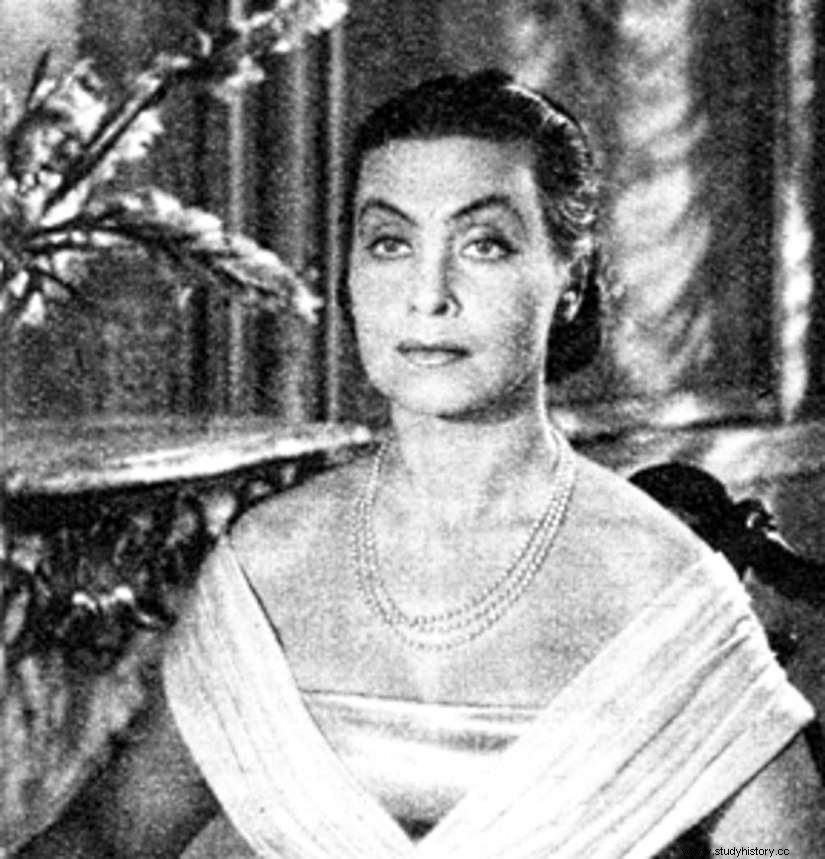
Nina Andrycz in the historical film Warsaw Premiere (photo:public domain)
Her sculptural figure and classic facial features perfectly harmonized with the ideal of beauty promoted by Dior. Every day she paraded in flowery taffeta dresses, black, tight-fitting garments and fur coats with an inherent string of pearls around her neck. In her cavernous wardrobe she had Stalin mink (apparently she never wore them) and a white ermine stole from Mao Zedong in which she has appeared in the past.
In the 1950s and 1960s, the eyes of Polish women eager for fashion inspiration were focused on her. Not only because she was a famous actress, but also because she was married in 1947 to the then prime minister, Józef Cyrankiewicz. The couple, although rather unfortunate, survived over 20 years. The spouses' priorities differed - he wanted children, she only thought about a career.
“If I had at least a squirrel for him, he would be with me for the rest of his life. Oh yes? He went across the street to the dentist because he had a toothache, and that's how the romance began, ”she recalled. Before that happened, Nina Andrycz managed to change the way women were dressed in the People's Republic of Poland. As the famous blogger Karolina Żebrowska writes about it in her book Polish Beauty. A hundred years of fashion and style ” :
One can risk a statement that her fashionable appearance was one of the factors that contributed to the government's interest in Polish women's clothing and to the fashion revolution of the late 1950s (...) Nina Andrycz with her stylizations stung the eye of the communist authorities, showing that fashion and elegance should be valued and respected.
Girl with a song
Poles loved her and hated her at the same time. The press called Kalina Jędrusik a "demon of the senses", "a great scandal" or "the embodiment of condensed sex". And it's hardly surprising, since she wore ... a necklace with a cross to the low-cut dresses revealing her large breasts.
There were incredible stories about the controversial actress and singer, she was bathed in champagne and dozens of lovers were passing through her bed . Her tongue (she swore like a shoemaker) and performing in public without underwear have become legendary. Today she is remembered primarily for her performances in the Kabaret Starszych Panów. Thanks to them, she gained the status of a star ... and shocked the moral awareness of the citizens of the Polish People's Republic. This is how her iconic creations were characterized by Maciej Maniewski:
She initially appears in Cabaret as a long-haired blonde, but then shortens her hair, replacing the natural blonde - forever - with a chestnut color. With bold make-up, it clearly marks the shape of the lips and eyes. The line of the figure is emphasized by the cut of the dress with a deep neckline. These features will remain the hallmark of Kalina.
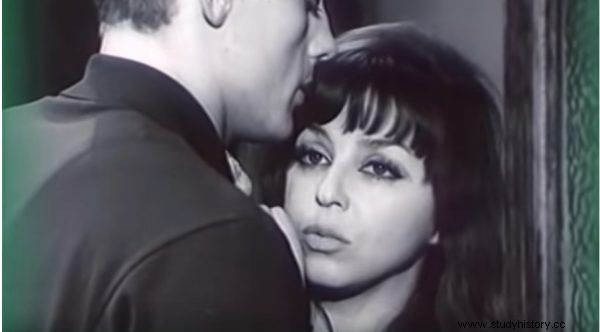
Kalina Jędrusik, still from the film "Jowita" from 1967, directed by Janusz Morgenstern.
However, she herself did not feel like an icon. On the contrary. She believed that her beauty and talents had never been fully appreciated. "I have been plucked of my colored feathers" - she said. And she was quite right, because although she was a sex symbol for thousands of Poles, she did not fit the female types "recommended" by the communist authorities. Therefore, her talent was irretrievably wasted.
A face to die for
Short, pastel dresses, ruffled ruffles, checked coats and high-waisted tunics - in the People's Republic of Poland at the end of the 1960s, these outfits were "the last cry of fashion". And this is what Mariola, played by Pola Raksa, was like, the main character of the comedy "Adventure with a song" from 1968. No wonder she found multitudes of followers. The more that in those days almost every Polish woman dreamed of looking like an idol from the screen.
Pola Raksa is still considered to be the most beautiful actress in the history of Polish cinema . It was beauty that opened her way to a career. Nineteen-year-old Apolonia, as her full name sounded, did not plan to earn a living by performing in front of the camera. She was a student of Polish studies when (fortunately or not) she was noticed by a photographer working for the youth weekly "Around the World" in a milk bar. It was put on the cover and her photo immediately caused a sensation.
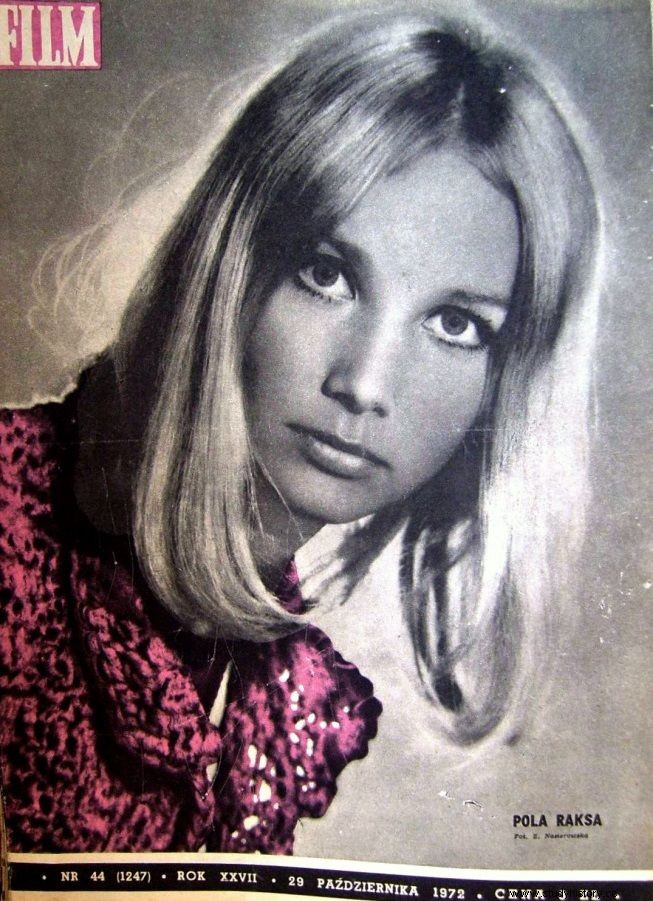
Pola Raksa on the cover of FILM magazine from 1972
Raksa's further path to the silver screen was very easy. Proposals for the next roles soon followed. Each director wanted a beautiful actress in the cast, whose style perfectly reflected the current trends. As iconic as her clothes were Pola's hair. This is how describes them in the book “Polish Beauty. One hundred years of fashion and style ”Karolina Żebrowska :
Pola's characteristic hairstyle - in line with the fashion of the end of the decade (long hair by the shoulders, strongly raised at the back of the head with a tapir, symmetrically parted front, smooth sideways - it quickly became hers her trademark and she wore its variations even in historical films.
Poles fell in love with her immediately - especially after she played the role of Marusia in the series "Czterej pancerni i pies" . However, when Raksa was at the height of fame, she suddenly gave up her acting career. It was more on the way with fashion. In her "retirement", she started designing clothes. Among other things, she created costumes for Ewa Błaszczyk's recital at the Studio Theater in Warsaw in 1999. For some time, she also ran her own fashion column in Rzeczpospolita. Later she fell like a stone into water. To this day, it is not known what he does.
Colorful stage birds
Although they apparently had nothing in common, they had something in common:a creative approach to the stage image. It turned the eyes of all Poland towards them.
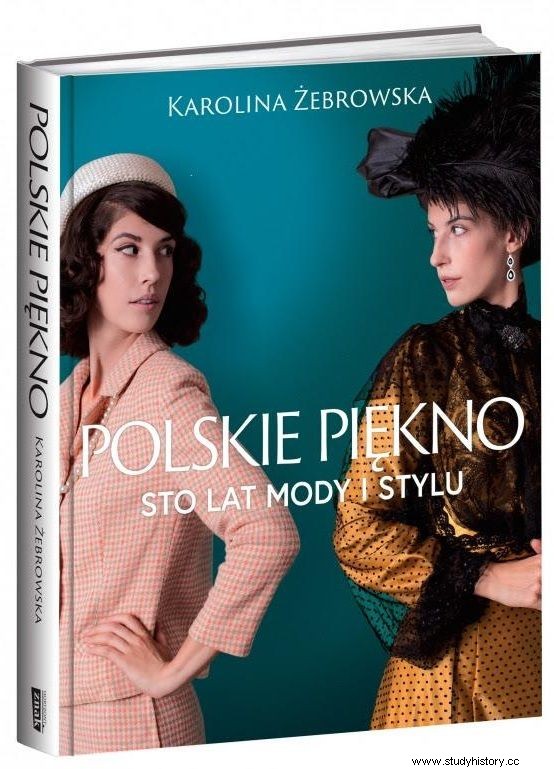
In the 1970s, Maryla Rodowicz shocked the audience and the artistic world with her ideas for concert creations. Wprost loved the costumes stylized in Indian folklore and the triumphant then hippie fashion "children of flowers". Jerzy Antkowiak, the most famous designer of Polish Fashion, infected her with love for traditional folk handicrafts. He suggested a collector who supplied her with hand-embroidered blouses and scarves.
Barbara Hoff wrote about her in 1977 in Przekrój:“If you know what she looks like, you also know how she is dressed, because it's hard not to notice. (...) She creates excellent costumes, with fantasy and panache. Courageous and without »am I beautiful?« ”. Later, Rodowicz changed her style many times, to the present, very bold outfits. In the history of Polish fashion, she went down above all as a colorful bird that lit up the gray reality of the People's Republic of Poland .
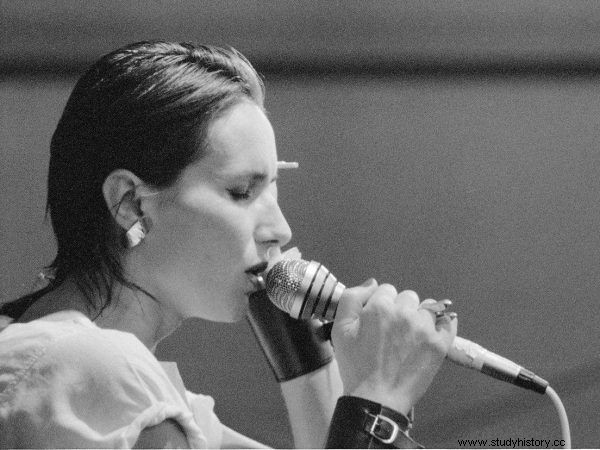
Kora in 1985 at the festival in Karlsruhe, Germany (photo:Herrzipp, license of GNU FDL)
At the opposite extreme when it comes to the style of dress and makeup, there was Olga Jackowska, or Kora - the fashion icon of the 80s. Her flashy, modern clothes once again revolutionized the approach to the stage image of stars, and at the same time perfectly matched the atmosphere of the era. . The style of the singer tried to imitate the more courageous teenagers of that time. As Karolina Żebrowska reports in her book :
(...) she liked to experiment with fashion, like foreign singers. However, Madonna's pop look, Siouxsie Sioux's punk outfits or the hippie-ballad-like atmosphere of Stevie Nicks (and Maryla Rodowicz - editor's note) did not appeal to her. Taking a little bit from each side, Kora has developed a style that is a combination of rock provocation with minimalist elegance .
How did it work in practice? The Maanamu singer combined large jackets with fishnet stockings, short skirts with black, transparent blouses and translucent tights with kimono-like jackets. On top of it all there was a characteristic hairstyle and inherent dark glasses. And although she was not (literally) as colorful as Rodowicz, with her clothes she perfectly reflected the spirit of the period of rebellion and breakthrough, when the PRL began to be talked about in the past tense ...
Bibliography:
- Maciej Maniewski, Kalina, or the icon of Eros , "Kino" No. 07/08 2003.
- Dariusz Michalski, Kalina Jędrusik , Iskry 2011.
- Witold Filler, Lech Piotrowski, A group of Polish actors. From Solski to Linda , Philip Wilson 1998.
- Emilia Padoł, Ladies of the People's Republic of Poland , Prószyński i S-ka 2015.
- Anna Pelka, Texas-land. Youth fashion in the People's Republic of Poland , Trio 2007 publishing house.
- Maryla Rodowicz, Jarosław Szubrycht, The Madman is dancing, Burda Media Polska 2013.
- Kamil Sipowicz, Kora, Kora. And the planets go crazy , Agora 2011.
- Jacek Tomczuk, Nina Andrycz's memory:Loneliness in the theater , "Newsweek" 27/02/2014.
- Karolina Żebrowska, Polish beauty. One hundred years of fashion and style , Horizon 2018 sign .
